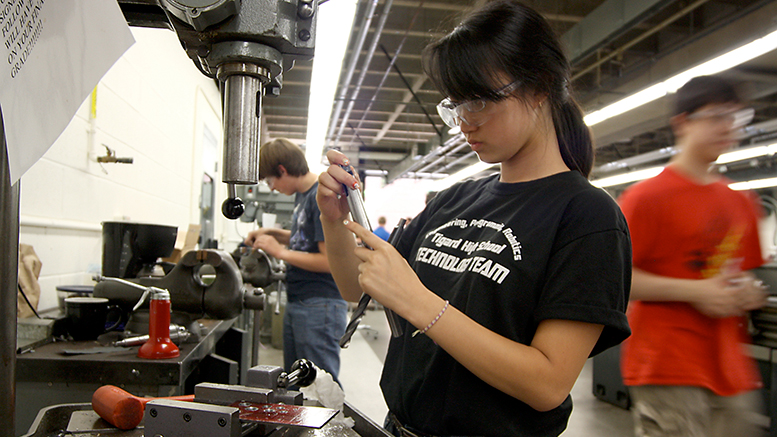“Unemployment rate hits 3.9%, a rare low, as job market becomes more competitive,” ran the May 4, 2018 headline of the New York Times.
And the pace hasn’t slowed; our country’s economy continues to soar, with new record low unemployment levels being tallied, accompanied by ongoing job growth.
Such momentum creates a skills gap for business and industry, in search of a trained, educated and diverse workforce to fill open positions at their companies and organizations. Their need presents a “sweet spot” for community colleges, partly because of the diversity of our students and also because of our expertise with career technical education (CTE) and our ability to produce that talent — if we have the necessary funding and employer partnerships.
CTE is a proven method to bolster the country’s continued economic success by meeting workforce needs and giving students the skills required to succeed professionally in high demand fields. It’s also the focus of research – specifically, by Georgetown University, which took a look at CTE in Oregon.
Researchers found that the number of certificates awarded by Oregon community colleges has more than tripled since 2007, with most growth tagged to short-term certificates. Certificate holders younger than 29 were found to experience significant wage increases. They tended to be Pell Grant recipients, with less work experience and lower earnings.
The study also determined that community college certificates typically increase earnings by 19 percent, or $5,000; that disciplines like business and health offer the best wage premiums; and that certificates serve as a crucial bridge for career transitions.
Short-term certificate programs are suited to adult students, particularly if they result in “stackable” credentials – meaning that credits earned at one level apply to the next level of training. Like many community colleges, the average Portland Community College (PCC) student is 28 years old and works while attending school. Certificate programs are well suited to their busy lives and also reflect the increasing pace of “upskilling” needed in the workplace given rapid technological change occurring in today’s jobs.
Making the case
I recently spoke to the Senate Career and Technical Education Caucus as part of a panel on advancing quality work-based learning. The panel’s focus was on the importance of CTE and budget reauthorization for the Carl D. Perkins Career and Technical Education Act. Such funding is critical because of data like that of the Georgetown study, demonstrating the impact of CTE. It also serves as a way to reverse Census Bureau statistics indicating that, as of 2015 in the United States, approximately 58 percent of adults over the age of 25 did not have an associate degree, and 12 percent did not have a high school credential (Educational Attainment in the US: 2015 US Census Bureau).
Oregon mirrors the nation’s economic explosion. We’ve recovered many more jobs than we lost during the Great Recession – and then some. Our unemployment rate continues to drop, and job growth and wages are up.
In my work at PCC, I talk with or meet employers daily, from a variety of high-growth CTE fields – welding, health information management, software development, manufacturing and industrial technology, to name a few – who are desperate for educated, skilled workers. Their companies boast middle-skill jobs that pay well, offer potential for career advancement, and are automation- and recession-resistant.
And their problem is that locally, they can’t find enough of the talent they need with the necessary training. So, they import that talent to bridge the gap.
Oregon’s 17 community colleges are united in tackling this dilemma. Together, we’ve submitted a state-funding proposal that, if backed, will significantly increase the number of skilled graduates from CTE programs across the state, ready to enter high-wage occupations. In essence, the skills gap Oregon is experiencing will be bridged; business and industry will have access to the educated labor they need – locally.
An added benefit is that such support will simultaneously increase completion rates among first-generation, low-income, highly diverse cohorts of students – leading to an increase in the diversity of the workforce.
Critical employer partnerships
Funding is half the battle, though. Employer partnerships are fundamental – actually, crucial – to solving the skills gap and building on the economic success we’re experiencing. The creation of work-based learning opportunities like apprenticeships, internships and co-operative education agreements are ways to do this. They braid CTE training with employer input so that curriculum, training practices and job skills meet industry demands.
PCC has developed a first-of-its-kind registered apprenticeship with Madden Industrial Craftsmen. Madden will serve as the country’s first staffing firm to offer a registered apprenticeship training program, with PCC’s oversight. At the end of the program, employees will receive apprenticeship and academic credentials recognized across the country.
Another example is PCC’s role as the training center partner in the Oregon Manufacturing Innovation Center project in Scappoose, geared toward the development of advanced manufacturing talent and made up of industry, higher education and government partners. The goal is to closely align applied research and development led by industry and university partners with PCC’s hands-on “earn and learn” apprenticeship training.
Our community – locally, in Oregon and nationally – is at a critical point. The good that accompanies sustained economic and population growth creates simultaneous challenges, like the rising cost of housing and subsequent affordability crisis, which can push lower-income families away from city centers.
Such dynamics inspire us: to meet workforce needs by bridging the skills gap; to ensure that those most in need of education have access, in order to build better lives for themselves and their families; and to accomplish this with limited resources. By way of increased state funding and industry partnerships, CTE can address such challenges head-on, meeting industry needs and offering students access to greater opportunity.





